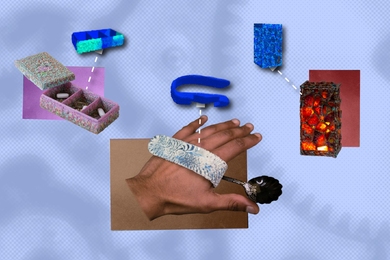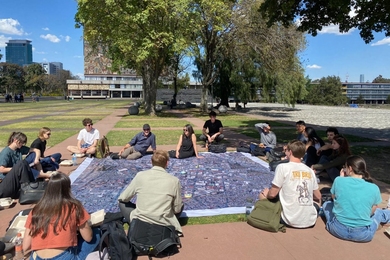CAMBRIDGE, Mass.--MIT scientists and colleagues have discovered a method for measuring key aspects of nuclear fusion that they plan to use at the National Ignition Facility (NIF), a planned stadium-sized complex of lasers that is due to begin operations in 2002.
NIF holds promise as a means to develop a future energy source, as a means of studying important physics related to how stars shine, and as a way to simulate critical aspects of nuclear-weapons functions.
An essential part of creating nuclear fusion at NIF is aiming 192 lasers at a chamber containing a 2.2-millimeter pellet of super-cold hydrogen fuel and causing an implosion with near-perfect symmetry.
If this is accomplished, 18 million joules of fusion energy--ten times the laser energy--will be created. However, if the symmetry is off by even one percent, the lasers will not create adequate nuclear fusion.
The new measuring system can assess both the symmetry of the implosion and the core conditions of the nuclear reaction. The measuring system, created by scientists at MIT, Lawrence Livermore National Laboratory and the University of Rochester, is detailed in the September 23 issue of Physical Review Letters.
"Our focus is to develop a diagnostic instrument that can measure the core density of the implosion and how symmetric the implosion is. Longer range, our goals are to establish whether fusion will be a viable energy source and to investigate new areas of science accessed through the NIF," said Richard Petrasso, a principal research scientist at MIT's Plasma Fusion Center (PFC) and one of the authors of the journal article. Chikang Li, a PFC research scientist, was also an author.
The NIF will most likely be built at Lawrence Livermore National Laboratory in California, although the site has not yet been selected. If the NIF is successful, it will be the first device in the world to achieve controlled thermonuclear ignition of the type that lights stars.
The heart of the ambitious design is a system of 192 individual lasers made of neodymium glass that together produce about 1.8 million joules of energy. That is equivalent to 500 trillion watts of power generated for four-billionths of a second.
The world's current largest laser, Nova, also at Lawrence Livermore, produces 45,000 joules of energy. That is about 15 trillion watts generated for three-billionths of a second.
As in previous experiments on Nova, the NIF lasers will be aimed at a chamber called a hohlraum that contains the pellet. When laser beams hit the hohlraum, their energy is converted into X-rays, which bathe the pellet uniformly and burn off its carbon-hydrogen surface. This explosive burning would cause the NIF pellet to implode to about one-thirtieth of its original ra-dius.
The hydrogen pellet then would fuse into helium at the core of the pellet, starting a fiery burn that would last less than a billionth of a second.
Scientists expect the NIF to create nuclear reactions with a temperature of about 100 million degrees Centigrade-seven times the temperature at the core of the sun-and a core density of 1,000 grams per cubic centimeter. That is about 50 times the density of gold, one of the most dense materials on earth, and about seven times the density of the sun's core.
"The resultant core will be very, very dense. We want to determine the conditions inside the ignited pellet," Dr. Petrasso said.
Dr. Petrasso and colleagues will be measuring protons created during nuclear fusion to determine both the density of the core and the symmetry of the implosion. The scientists are building a proton spectrometer, a device that will be able to make the measurements, with the goal of installing it at the NIF. In the meantime, Dr. Petrasso and others are testing early versions of the spectrometer at the University of Rochester's Laboratory for Laser Energetics and at the Lawrence Livermore Nova facility.
The first order of business for scientists working on the NIF will be to create sufficient nuclear fusion to obtain ignition (ten times the laser energy).
"We need to see if we can develop fusion as an energy source, and the NIF is one of the key steps to that end," Dr. Petrasso said.
Because of the unique temperature and density conditions expected at the core of the NIF, Dr. Petrasso and other scientists expect to be able to apply knowledge from the NIF to new areas of science, such as better understanding the fusion reactions that take place in stars, including our sun.
Another application of the NIF is defense. With the moratorium on weapons testing, the NIF would provide a way, on a microscopic scale, to assess the reliability of the current arsenal of nuclear weapons without actually testing them.
The US Department of Energy will spend $1.1 billion to construct the NIF by the year 2002.





